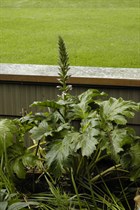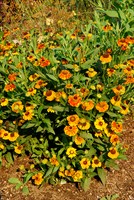We bought a house last year. Its landscape had been
neglected for a couple of years so we spent the year cleaning up,
trimming and deciding what was there that we liked. We like most of
the bushes. They're easy to take care of with one round of trimming
every year, which is what we like. We don't mind going out one
weekend in spring and working hard all weekend but we don't want to
have to go out every single weekend.
However, there's not much color except in spring when
most of the bushes bloom, and then in fall when some of them turn
color. What can we add for easy color to fill the gaps? - L.P.M.
-
Fill those gaps with perennials from this list.
We present the list three ways:
1) By light requirement: Sun, half sun, and shade
2) In order of peak bloom
3) In chart form by bloom sequence; with growing conditions and
maintenance notes. Download the chart:
as a pdf file (for
reading and printing only)
or as an Excel
file (if you wish to customize or expand it)
What's on the list
It contains perennials that provide the most color and neatest
look while requiring the least amount of attention and only the
most simple kinds of care. Everything on it was chosen for
attributes such as attractive plant shape and foliage color, as
well as the ability to remain presentable if only weeded, watered
and cut down once a year.
We considered flower color as a "plus" but not the primary
criterion, and selected only those plants with longer than average
blooming season. All plants are hardy in USDA hardiness zone 5 (to
-20°F); most will grow in zones 4-5-6 (minimum winter temperature
between -10°F and -30°F). Finally, we chose to offer something for
all ranges of light and provide a complete season. That is, to
include plants suited to sun and to shade, with some that peak in
early spring, others that look best in midsummer and some that are
most attractive in fall.
Important considerations when using the list
Some things to keep in mind as you choose which perennials to
grow in your landscape:
1) Perennials are great additions to a landscape but take their
marketing hype with a grain of salt. No perennial blooms all
summer. None are totally care-free. Most need yearly, individual
attention to remain healthy enough to bloom to the fullest and look
their best. In addition, most perennials' 2- to 4-week peak bloom
season is followed by a lackluster or messy decline.
2) Choose from this list, matching each plant to its ideal site
to come as close as possible to that advertised ideal of
simplicity, lots of color and very low care. Most need division
only after four or more years to maintain their vigor. If you plant
them in an environment that suits them, you can simply keep them
weeded and watered, and enjoy them for at least four years.
Exceptions are noted, such as the need for more frequent division,
or deadheading to extend bloom.
3) Patience required: The best perennials are not mile-a-minute
plants. These easy, best species will bloom and show their other
good characteristics in their first year but they need a
year to grow before they start showing you their full
potential. (The fastest growing perennials, such as daisies, also
need more care, more frequently.) If waiting is not an option, look
for specialty garden centers that cater to immediate needs, as
these may carry larger specimens of these plants.
When you arrange your chosen perennials:
1) Design with fewer types for greatest visual impact and
simplest care. Ten well-sited perennials can carry a scene.
2) Plant in masses equal to other landscape features. In most
cases, each of these perennials should be planted in a group of
five or more so it has a visual presence equal to a shrub.
3) More perennial design tips.
Easiest, best perennials:
Grouped by light requirement
In the sun
These plants need six or more hours of cast-a-shadow sunlight
each day, with loose, deep soil and regular water:
Windflower / pasqueflower (Pulsatilla vulgaris /
Anemone pulsatilla)
Cushion spurge (Euphorbia polychroma)
Catmint (Nepeta mussinii
hybrids)



Zebra iris (Iris pallida, variegated forms)
Below, variety 'Aureo-variegata'
Gas plant (Dictamnus albus)
Carpathian
bellflower (Campanula carpatica)



Lady's mantle (Alchemilla mollis)
False indigo
(Baptisia australis)
Border jewel (Polygonum affine)



Big betony (Stachys micrantha / S.
monieri)
Ornamental sage
(Salvia superba / S. nemerosa)
Siberian iris (Iris sibirica)



Foxglove beardtongue (Penstemon digitalis)
Feather reed grass (Calamagrostis acutiflora)
Dwarf, repeat-blooming daylily (Hemerocallis hybrids)



Bear's breeches (Acanthus spp.)
Blanket flower
(Gaillardia hybrids) (Red-centered orange disk
flowers)
Threadleaf
coreopsis (Coreopsis verticillata)



Veronica
Hardy hibiscus / Swamp mallow (Hibiscus moscheutos
hybrids)
Dwarf hybrid goldenrod (Solidago hybrids)



Helen's flower (Helenium angustifolium)
Butterfly bush (Buddleia davidii varieties)
Clump sedum (Sedum spectabile, S. sieboldii and
others)



In part sun
These plants need 4 to 6 hours of sunlight per day, with loose,
deep soil and regular water
Lenten rose (Helleborus
hybrids)
Fringed bleeding heart (Dicentra eximia)
Willow-leaf blue star (Amsonia tabernaemontana)



Variegated sweet Solomon's seal (Polygonatum odoratum
variegatum)
Hybrid coral bells (Heuchera and
Heucherella varieties)
Dropwort / Meadowsweet (Filipendula vulgaris)



Cranesbill (Geranium species)
Masterwort (Astrantia species)
Dalmatian bellflower (Campanula portenschlagiana)



Goatsbeard (Aruncus dioicus)
Dwarf goatsbeard (Aruncus
aethusifolius)
Golden bleeding heart (Corydalis lutea)



Dwarf astilbe (Astilbe chinensis)
Turtlehead (Chelone
obliqua)
Fall fairy candle (Actaea ramosa / Cimicifuga
ramosa)



Hybrid cardinal flower (Lobelia x speciosa)
Blue bush clematis (Clematis heracleifolia)


In shade
These perennials can grow well in as little as 2 to 4 hours of
sunlight per day, with loose, deep soil and regular water
Lenten rose (Helleborus
hybrids)
Bethlehem sage (Pulmonaria species and varieties)
Fringed bleeding heart (Dicentra eximia)



Red baneberry (Actaea rubra)
Variegated sweet Solomon's seal (Polygonatum odoratum
variegatum)
Goatsbeard (Aruncus dioicus)



Golden bleeding heart (Corydalis lutea)
Hosta species & varieties
Turtlehead (Chelone obliqua)



Fall fairy candle (Actaea ramosa / Cimicifuga
ramosa)
Blue bush clematis (Clematis heracleifolia)


Easiest, best
perennials in order of peak bloom
Lenten rose (Helleborus
hybrids)
Windflower / pasqueflower (Pulsatilla vulgaris /
Anemone pulsatilla)
Bethlehem sage (Pulmonaria species and varieties)
Pardon our dust.
More images and image-links coming here,
the gateway to our perennial image gallery.
Meanwhile, the pdf chart is fully illustrated.
Also, you can Sponsor us to speed the process!
Cushion spurge (Euphorbia polychroma)
Fringed bleeding heart (Dicentra eximia)
Red baneberry (Actaea rubra)
Catmint (Nepeta
mussinii hybrids)
Zebra iris (Iris pallida, variegated forms)
Willow-leaf blue star (Amsonia tabernaemontana)
Variegated sweet Solomon's seal (Polygonatum odoratum
variegatum)
Hybrid coral bells (Heuchera and
Heucherella varieties)
Gas plant (Dictamnus albus)
Pardon our dust.
More images and image-links coming here,
the gateway to our perennial image gallery.
Meanwhile, the pdf chart is fully illustrated.
Also, you can Sponsor us to speed the process!
Dropwort / Meadowsweet (Filipendula vulgaris)
Carpathian
bellflower (Campanula carpatica)
Cranesbill (Geranium species)
Lady's mantle (Alchemilla mollis)
Masterwort (Astrantia species)
Dalmatian bellflower (Campanula portenschlagiana)
False indigo
(Baptisia australis)
Goatsbeard (Aruncus dioicus)
Border jewel (Polygonum affine)
Big betony (Stachys micrantha / S. monieri)
Ornamental
sage (Salvia superba / S. nemerosa)
Siberian iris (Iris sibirica)
Foxglove beardtongue (Penstemon digitalis)
Feather reed grass (Calamagrostis acutiflora)
Dwarf goatsbeard (Aruncus aethusifolius)
Golden bleeding heart (Corydalis lutea)
Daylily (Hemerocallis hybrids)
Bear's breeches (Acanthus spp.)
Blanket flower
(Gaillardia hybrids)
Threadleaf coreopsis
(Coreopsis verticillata)
Hosta
Veronica
Dwarf astilbe (Astilbe chinensis)
Turtlehead (Chelone obliqua)
Fall fairy candle (Actaea ramosa / Cimicifuga
ramosa)
Hybrid cardinal flower (Lobelia x speciosa)
Blue bush clematis (Clematis heracleifolia)
Hardy hibiscus / Swamp mallow (Hibiscus moscheutos
hybrids)
Dwarf hybrid goldenrod (Solidago hybrids)
Helen's flower (Helenium angustifolium)
Butterfly bush (Buddleia davidii varieties)
Clump sedum (Sedum spectabile, S. sieboldii
and others)